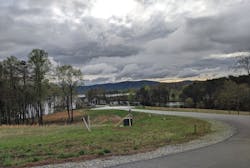About the author:
Nadean Carson is principal engineer for Parker Design Group. She can be reached at [email protected].
by Nadean Carson
undefinedThe construction industry has seen many changes in environmental regulations over the past 20 years. One of the biggest threats to local waterways comes from unmanaged sediment runoff from construction activities, primarily, grading operations.
In Virginia, this issue is addressed through the Virginia Pollutant Discharge Elimination System (VPDES) and regulated with a Construction General Permit (CGP) during land disturbing activities. This CGP outlines what precautions must be put into place to protect waterways from sediment and other pollutants that may be discharged during construction. The permit outlines what erosion and sediment controls must be installed to protect waterways, as well as what storm water controls must be installed to protect the storm water from other pollutant discharges.
In 2015, Parker Design Group (PDG) started a Stormwater Division with a focus on working with contractors and owners to keep them in compliance with the CGP. Some contractors needed assistance with the paperwork aspect of keeping up the storm water permit, while others wanted to have the assurance that experienced inspectors were watching the project to ensure compliance with regulations. Regardless of the reasons, the most successful projects seem to occur when inspections were performed with a project team mindset.
Pinpointing Priorities
In 2017, work began on a 28-acre lakeside property being developed into a residential neighborhood. The development had miles of shoreline, so storm water management was at the top of the priority list of local enforcement agencies. The owner contracted PDG to provide storm water inspection and construction administration services. After the bidding stage, the grading contractor selected was an “old-school” contractor.
In this case, this meant skipping over the installation of many erosion and sediment control measures. In particular, diversion ditches designed to divert water away from the site were not installed. These were vital to control the amount of water that storm water structures were designed to manage. The lack of these perimeter control items was pointed out at multiple site progress meetings and was met with assurance they would be installed later. The owner’s representatives continued to note this deviation in the inspection logs and repeatedly requested that they be installed immediately.
On February 11, 2018, the area received 6 inches of rain over less than 12 hours. Erosion and sediment control measures, such as sediment traps, sediment basins and silt fence are typically designed to handle approximately 2 to 3 inches of rainfall over a 12-hour timeframe. The intense rain event overwhelmed the existing sediment control measures installed onsite, resulting in a discharge of sediment-laden water from emergency overflow structures.
The problem was that the perimeter control measures—such as the diversion ditches on top of the slopes coming onto the site—had not been installed at all. These perimeter control measures aimed to divert ‘clean’ water around the site, reducing the quantity of ‘dirty’ (sediment laden) water going to the sediment control basins. When the contractor neglected to install these measures, the quantity of storm water flow that was not accounted for was now entering the site, resulting in a failure of a recently constructed roadway.
The water created an erosion channel approximately 8 feet deep on the edge of the roadway, dumping sediment into a small ravine that led to a delineated stream. The sediment was observed to flow into the stream for approximately 130 linear feet.
The Virginia Department of Environmental Quality was contacted concerning the impact from the sediment deposit into the delineated stream. A joint effort resulted in a directive to the contractor to immediately correct any outstanding erosion and sediment controls, install additional silt fence in the impacted area and rebuild the eroded roadway.
To reduce impact on the waterways, the contractor was directed to remove sediment from the waterway by hand shovels and buckets, which would keep heavy equipment out of the area of the stream and reduce further impact. The sediment above the stream would be removed by small pieces of equipment with instruction to limit disturbance as much as possible. The disturbed areas were immediately seeded and heavy straw was applied to provide temporary stabilization.
In addition to remediating the area of sediment release, the roadway that had washed out also need to be reconstructed. This proved to be difficult, as the material that had washed away now had a higher moisture content and needed to be dried to achieve compaction. Material from other parts of the site were trucked to the location to provide suitable material for reconstruction. It was also difficult to tie the reconstruction into the existing road to ensure no slip lines remained.
The cleanup of this sediment loss was costly, but the real impact was the loss of public trust. The development is in a rural area and neighbors had expressed concern about subdivision development. The owners spent months earning their trust and getting them on board. This one event eroded the trust built between the owner and the community.
In the case of loss of time, the impact to the schedule was important as it impeded the target date for sales of the residential lots. The loss of market during this time cannot be directly measured but was a factor in selling lots. Most owners look to buy property in the spring, but this event pushed the sales event into summer with fewer buyers in the market. Another cost associated with non-compliance is the additional construction administration time spent providing constant oversight of the contractor. Since the contractor fully acknowledged that initially he did not strictly comply with the project plans, the owner required inspectors on site daily to document the progress and ensure the contractor was complying with regulations. If the initial bid that won this project were cheaper, these factors certainly leveled the playing field.
Moving Forward
Failure of contractors to install the designed storm water measures often result in failures on site. Construction should be a collaboration, not a confrontation. The design engineers work closely with approving municipalities to ensure that their standards are met. The measures designed for the site are placed on the plans for a reason, even if the contractor does not readily understand why. It could be to conform to storm water calculation requirements or it could be to prevent catastrophic loss on site from additional water flowing onto a roadway. By approaching a project as a team rather than pointing fingers, the project tends to be completed on-time and within budget, primarily because the team is focused on creating solutions rather than more problems.
Site development construction was completed in 2019 and now has approximately 75% of the lots sold. The site has all storm water control measures installed, roads have been paved, and the site has been fully stabilized with vegetation. There have been several heavy rainfall events and no significant damage has occurred onsite. The water flows as it was designed and is safely treated before being released offsite.






